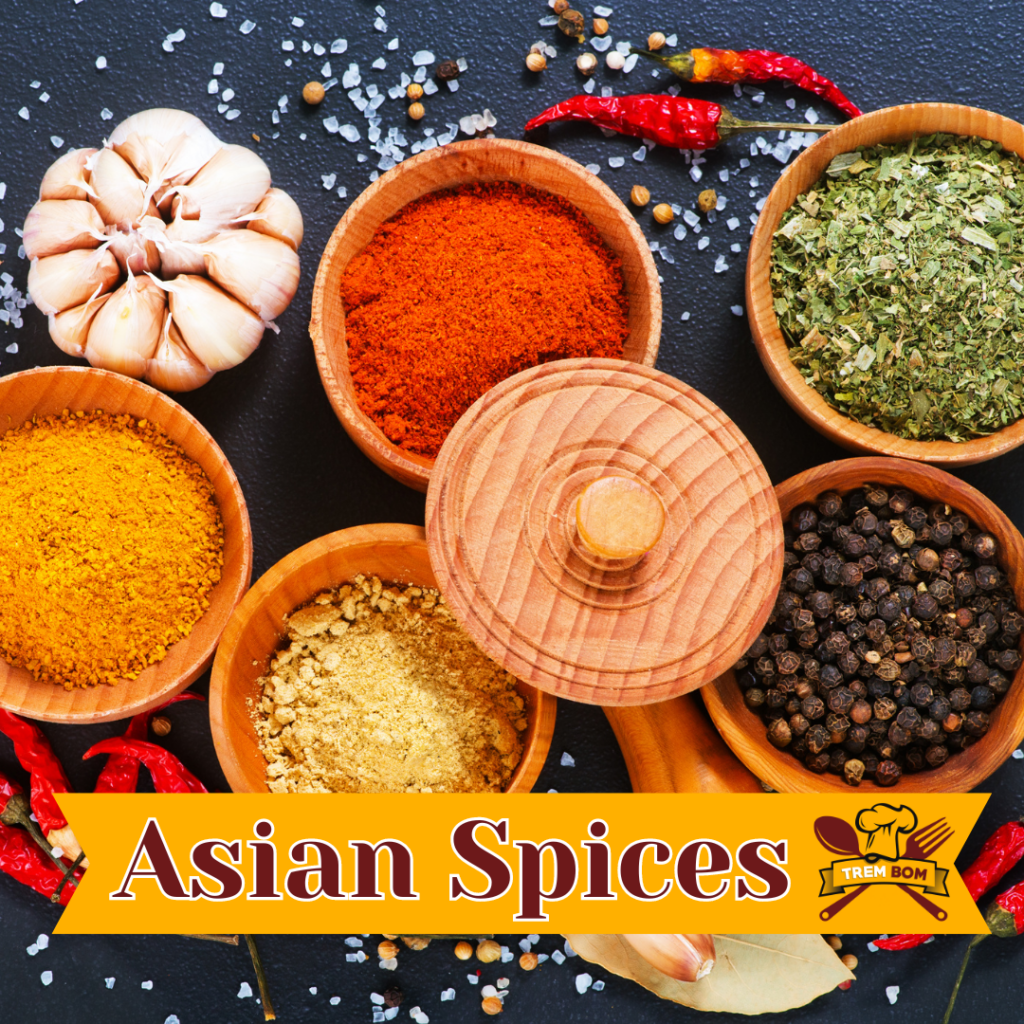
When it comes to Asian cuisines, spices are an essential ingredient that play a crucial role in adding depth, complexity, and flavor to dishes. From the fiery heat of chili peppers to the aromatic sweetness of cinnamon, Asian spices offer a diverse range of tastes that take your taste buds on a journey through flavors.
Asian spices are not only used for flavoring, but they also hold a significant cultural and historical significance. In some cultures, certain spices are believed to have medicinal properties that can improve health and well-being. In this article, we will explore the world of Asian spices and how they contribute to the diverse and delicious cuisines of Asia.
Key Takeaways:
- Asian spices are a vital element in Asian cuisines.
- They offer a diverse range of flavors that add complexity and depth to dishes.
- Spices hold cultural and historical significance, with some believed to have medicinal properties.
The Magic of Asian Spices: Aromatic and Flavorful Seasonings
Asian spices are renowned for their aromatic and flavorful qualities, bringing a unique taste profile to dishes. From the sweet notes of cinnamon to the spicy kick of ginger and the anise-like flavor of star anise, these seasonings play a crucial role in Asian cuisine.
By utilizing a blend of these spices, Asian chefs create complex and rich flavors, transforming bland dishes into taste sensations. The combination of sweet, sour, salty, and spicy flavors characterizes many Asian dishes, and the use of spices is a significant factor in achieving this balance.
The aromatic and flavorful qualities of Asian spices make them a versatile ingredient in the kitchen. Whether you’re making a savory stir-fry, a hearty curry, or a refreshing salad, these seasonings add a unique dimension to your dishes.
One of the great things about Asian spices is that they are incredibly versatile and can be used in both sweet and savory dishes. Cinnamon, for example, is a popular spice in sweets but is also used in savory dishes such as pho to add depth of flavor.
Asian spices also pair well with a variety of ingredients, including meats, vegetables, seafood, and noodles. This versatility makes them an essential ingredient in any pantry, allowing you to experiment with new flavors and create exciting dishes.
Essential Asian Spices: A Guide to Commonly Used Ingredients (Ginger, Cinnamon, Star Anise, and Turmeric)
Asian cuisines are known for their bold and intricate flavors, which are achieved through the use of a wide variety of spices. Here is a guide to essential Asian spices that are commonly used in Asian cooking.
| Spice | Flavor Profile | Common Uses |
|---|---|---|
| Ginger | Warm, pungent, and slightly sweet | Used in stir-fries, soups, marinades, and tea |
| Cinnamon | Sweet, warm, and woody | Used in desserts, curries, and stews |
| Star anise | Sweet, licorice-like, and slightly bitter | Used in braised dishes, soups, and marinades |
| Turmeric | Earthy, slightly bitter, and peppery | Used in curries, rice dishes, and marinades |
These spices are just a few examples of the vast array of flavors that can be found in Asian cooking. By incorporating these essential Asian spices into your cooking, you can take your dishes to the next level and experience the true essence of Asian cuisine.
The Top Asian Spices: Must-Haves for Authentic Asian Cuisine (Five Spice, Thai Curry Powder, Clove, & Galangal)
To create authentic Asian dishes, using the right spices is crucial. Here are some of the top Asian spices that are a must-have in your pantry:
| Spice | Flavor Profile | Commonly Used In |
|---|---|---|
| Five Spice | A sweet and savory blend of cinnamon, fennel, star anise, cloves, and Sichuan peppercorns | Chinese cuisine, especially in meat dishes and stir-fries |
| Thai Curry Powder | A mix of coriander, cumin, turmeric, lemongrass, and red pepper | Thai curries, soups, and marinades |
| Clove | A warm and sweet spice with a strong flavor | Indian cuisine, especially in biryanis and curries |
| Galangal | A pungent and citrusy spice with a ginger-like flavor | Indonesian and Thai cuisine, usually in soups and curries |
These spices add depth and complexity to your dishes, and using them will transport your taste buds straight to Asia. Don’t be afraid to experiment and mix and match spices to find your own unique flavor combinations.
A Fragrant Journey: Exploring Aromas in Asian Spices
Asian spices not only add flavor to dishes, but also contribute to their unique and delightful aromas. Each spice has its own distinct scent that can transport your senses to another place. From earthy turmeric to sweet cinnamon, the fragrance of Asian spices is a key component of the overall experience of Asian cuisine.
One of the most recognizable and beloved aromas in Asian cooking is that of fresh ginger. Its warm, spicy scent fills the air and immediately ignites the appetite. Another popular spice, star anise, has a licorice-like aroma that enhances the aroma of soups and stews. Whether it’s the smoky, woody scent of clove or the floral aroma of cardamom, Asian spices have an incredible range of fragrances that can enhance any dish.
The Role of Aromas in Asian Spices
For many Asian cuisines, the fragrance of spices is just as important as their taste. A dish that smells delicious will immediately stimulate the senses and create anticipation for the flavors to come. The aromas of spices can also evoke memories and emotions, making them an integral part of cultural and personal traditions.
Aromas also play a crucial role in the healing properties of some Asian spices. In Ayurvedic medicine, the scent of spices is believed to have a therapeutic effect on the mind and body. For example, the warm, woody aroma of turmeric is thought to promote relaxation and boost mood.
Exploring Aromas in Your Cooking
To fully appreciate the fragrances of Asian spices, it’s important to consider not only their taste, but also their smell when cooking. The heat and steam from cooking can release the oils in the spices and intensify their aromas. Adding spices at different times during cooking can also create a layered and complex fragrance profile.
It’s also worth experimenting with different spice blends to discover new and exciting aromas. For example, a blend of cumin, coriander, and turmeric can create a warm and earthy scent, while a mix of lemongrass, ginger, and garlic can produce a bright and zesty aroma.
Incorporating the fragrance of Asian spices into your cooking can elevate your dishes to new heights, satisfying both your senses and your appetite.
The Versatility of Asian Spices Used in Asian Cooking: From Soups to Stir-Fries
Asian spices are known for their distinctive flavors and aromas, which make them a popular addition to a variety of dishes, including soups and stir-fries. These spices can be used to add depth and complexity to the flavors of food, as well as to enhance its nutritional value.
For example, ginger is a common spice used in Asian cooking that is known for its digestive properties. It is often added to soups and broths to help soothe upset stomachs and relieve nausea. Meanwhile, star anise is another popular spice that is used to add a subtle sweetness to soups and stews.
When it comes to stir-fries, Asian spices like five spice and Sichuan peppercorns can add a bold and spicy kick to your dishes. Five spice, which is a blend of cinnamon, cloves, fennel, star anise, and Sichuan peppercorns, can be used as a seasoning for meat, vegetables, and noodles. Meanwhile, Sichuan peppercorns can add a numbing sensation and a distinct taste to stir-fry dishes.
Another commonly used spice in Asian cuisine is turmeric, which is often added to curries and marinades. It imparts a warm, earthy flavor to dishes and is also known for its anti-inflammatory properties.
Overall, the versatility of Asian spices allows for endless possibilities in the kitchen. From soups to stir-fries, these spices can add unique and complex flavors to your dishes, while also providing potential health benefits.
Exploring Regional Flavors: Asian Spices in Different Cuisines
Asian spices play a prominent role in various regional cuisines, each with its unique flavor and aroma. From the bold and spicy flavors of Sichuan cuisine to the fragrant and sweet spices of Indian cuisine, it’s fascinating to see how Asian spices are used across different regions. Here’s a closer look at some of the most popular Asian spices in various cuisines:
Vietnamese
One of the most commonly used spices in Vietnamese cuisine is lemongrass, a fragrant herb that imparts a lemony and floral flavor to dishes. Another staple is fish sauce, which is used as a seasoning and a dipping sauce. Vietnamese cuisine also incorporates a variety of fresh herbs, such as basil, mint, and cilantro, which add depth to the flavors.
Sichuan
Known for its bold and spicy flavors, Sichuan cuisine relies heavily on the use of spices such as Sichuan peppercorns, chili peppers, and ginger. These spices not only add heat to dishes but also create a numbing and tingling sensation in the mouth. Sichuan cuisine also incorporates a fermented chili bean paste, which adds a rich umami flavor to dishes.
Indian
Indian cuisine is known for its complex spice blends, including garam masala, curry powder, and tandoori masala. These blends typically include spices like cumin, coriander, turmeric, and cardamom, which add warmth and depth to dishes. Indian cuisine also uses a variety of whole spices like cloves, cinnamon, and bay leaves, which are often fried in oil before being added to dishes.
Chinese
Chinese cuisine relies on a variety of spices, including five-spice powder, which is a blend of cinnamon, cloves, fennel, star anise, and Sichuan peppercorns. Other commonly used spices include ginger, garlic, and scallions, which add fragrant and savory notes to dishes. Chinese cuisine also incorporates a variety of fermented sauces, such as soy sauce and oyster sauce, which add depth and umami flavor.
Japanese
Japanese cuisine uses a variety of spices, including wasabi, ginger, and sesame seeds. Wasabi, a pungent green paste, adds a spicy and sinus-clearing kick to dishes. Ginger is used to add a sweet and fragrant note to dishes, while sesame seeds are often used as a garnish. Japanese cuisine also incorporates a variety of fermented sauces, such as soy sauce and miso paste, which add depth and umami flavor.
As you can see, Asian spices are used in various ways to create unique and distinct flavors across different regional cuisines. Whether you’re a fan of bold and spicy flavors or fragrant and sweet aromas, there’s something for everyone in the world of Asian cuisine.
Beyond Taste: The Healing Properties of Asian Spices
Asian spices not only add a burst of flavors to dishes, but they also offer various health benefits! For centuries, these spices have been used in traditional medicine to treat an array of conditions. In this section, we’ll explore the healing properties of Asian spices and how they can benefit your health and wellbeing.
Reducing Inflammation
Many Asian spices, such as turmeric, ginger, and cinnamon, have powerful anti-inflammatory properties. Inflammation is linked to several chronic conditions, including arthritis, heart disease, and cancer. By incorporating these spices into your diet, you may help reduce inflammation and lower your risk of developing these illnesses.
Boosting Immunity
Several Asian spices, such as garlic, onions, and ginger, have immune-boosting properties. These spices can help increase the production of white blood cells, which are responsible for fighting off infections and diseases. By adding these spices to your meals, you may help strengthen your immune system and protect against illness.
Improving Digestion
Asian spices like cumin, coriander, and fennel are commonly used in traditional medicine to aid digestion. These spices help stimulate the production of digestive enzymes, which can help alleviate symptoms of indigestion, bloating, and constipation.
Regulating Blood Sugar
Several Asian spices, including cinnamon and fenugreek, have been shown to help regulate blood sugar levels. These spices can increase insulin sensitivity and improve glucose metabolism, which can be beneficial for people with diabetes or those at risk of developing the condition.
By incorporating these amazing spices into your diet, you can not only enjoy their delicious flavors but also reap their many health benefits. So, go ahead and spice up your dishes with these healing ingredients!
Spices Around the World: Asian Seasoning and Flavors in Global Cuisine
Asian spices have become increasingly popular in global cuisine, making their way into fusion dishes and inspiring chefs all over the world. The unique flavors and aromas of Asian spices can add depth and complexity to any dish, creating a truly unforgettable culinary experience.
Asian Flavors in European Cuisine
Asian spices like ginger, lemongrass, and coriander have been incorporated into European cuisine, creating fusion dishes that blend the best of both worlds. For example, the popular Vietnamese dish, pho, has made its way into French cuisine, inspiring chefs to create their own versions with a French twist.
The versatility of Asian spices has also been utilized in creating fusion desserts. Matcha, a popular Japanese spice, has been used to flavor everything from ice cream to cake to give them a unique and delicious twist.
Asian Flavors in American Cuisine
The influence of Asian spices can also be seen in American cuisine, particularly in dishes like spicy Asian-style wings and Korean BBQ tacos. Many chefs have also incorporated Asian spices like turmeric, cumin, and coriander into their rubs and marinades for grilled meats, adding a bold and flavorful twist to classic American dishes.
Additionally, the popular Thai dish, pad thai, has become a staple in many American households and restaurants, showcasing the versatility and appeal of Asian flavors in global cuisine.
Asian Flavors in Middle Eastern Cuisine
Asian spices have also influenced Middle Eastern cuisine, particularly in Moroccan and Persian dishes. Spices like cinnamon, turmeric, and cumin are used to create flavorful stews and meat dishes, adding a touch of Asian flavor to these traditional dishes.
The use of Asian spices in Middle Eastern cuisine highlights the versatility and universal appeal of these flavorful ingredients.
Asian Flavors in African Cuisine
Asian spices have also made their way into African cuisine, particularly in East African dishes like pilau rice and samosas. The use of spices like cardamom, cinnamon, and cumin adds a complex and aromatic flavor to these popular dishes.
Additionally, the use of Asian spices in African cuisine highlights the cultural and historical influences between the two regions, showcasing the interconnectedness of global cuisine.
Cooking with Asian Spices: Tips and Techniques
Asian spices can add a burst of flavor to any dish, but working with them can be intimidating, especially if you’re unfamiliar with the ingredients. Here are some tips and techniques to help you make the most out of cooking with Asian spices.
1. Toasting Spices
Toasting spices, like cumin or coriander seeds, brings out their natural oils and intensifies their flavors. To toast your spices, simply heat a dry frying pan over medium heat and add your whole spices. Toast for a few minutes, stirring occasionally until the spices are fragrant and slightly darker in color. Be careful not to burn them as this will result in a bitter taste.
2. Grinding Spices
Many Asian spices are sold as whole seeds or pods and need to be ground before use. A spice grinder or mortar and pestle can be used to grind your spices into a powder. Alternatively, you can use a rolling pin to crush your spices, although this may take longer. Ground spices lose their potency over time, so it’s best to grind them just before use.
3. Balancing Flavors
Using too much of one spice can overpower your dish and make it unpalatable. It’s important to balance your flavors by using a variety of spices in moderation. Experiment with different combinations to find what works well together.
4. Adding Spices
Some spices, like cumin or coriander, can be added at the beginning of cooking to infuse flavors throughout the dish. Others, like chili or garlic, are better added towards the end of cooking to maintain their intensity. It’s important to follow recipes carefully to ensure that your spices are added at the right time.
5. Storage
Spices should be stored in a cool, dry place away from sunlight and moisture. Avoid storing your spices near the stove as heat can denature the oils and affect the flavors. Ground spices should be used within six months, while whole spices can last up to a year.
By following these tips and techniques, you can elevate your cooking with Asian spices and create flavorful dishes that will leave everyone wanting more.
Exploring the Asian Spice Market: Where to Find and Buy
When it comes to finding and buying Asian spices, there are various options available. Local Asian grocery stores are a great place to start, offering a wide range of spices at competitive prices. These stores often source their spices directly from the countries of origin, ensuring their authenticity and quality. Look for stores that specialize in Asian cuisine or have a dedicated spice section.
If you can’t find what you’re looking for locally, online retailers such as Amazon and Spice Jungle offer an extensive selection of Asian spices, including hard-to-find varieties. Be sure to read reviews and check the credentials of the seller before making a purchase to ensure the spices are fresh and of good quality.
For those who enjoy traveling and exploring food markets, visiting Asia is a dream come true. Local markets are an excellent source of freshly ground spices and exotic blends that are difficult to find elsewhere. Some popular spice markets include Aleppo in Syria, Istanbul in Turkey, and the Kowloon City Market in Hong Kong.
Whether you’re a professional chef or a home cook, finding and buying Asian spices is now more accessible than ever. So why not embark on a culinary adventure and explore the diverse range of flavors that Asian spices have to offer?
Conclusion
Asian spices are an essential element of Asian cuisines, and their impact on the culinary world cannot be overstated. From the aromatic and flavorful nature of these seasonings to their potential health benefits and versatility, these spices offer a unique and exciting journey through flavors.
Whether you’re a professional chef or a home cook, learning to use Asian spices can take your cooking to the next level. By exploring the different spices commonly used in Asian cooking and understanding their unique flavors and aromas, you can create authentic Asian dishes that will impress your guests and delight your taste buds.
At the same time, the use of Asian spices is not limited to traditional Asian cuisine. Chefs all over the world have embraced these flavors and incorporated them into a wide variety of global dishes, resulting in unique fusion blends that offer a whole new level of taste experiences.
So, embark on your own culinary adventure today, and explore the world of Asian spices. With a little bit of experimentation and creativity, you’ll be amazed at the incredible flavors you can create.
FAQ
What are Asian spices?
Asian spices refer to a variety of seasonings and herbs commonly used in Asian cuisines. These spices add unique flavors and aromas to dishes, contributing to the distinct taste profiles of Asian cuisine.
What are some examples of Asian spices?
Some examples of Asian spices include ginger, garlic, turmeric, cinnamon, star anise, cardamom, cloves, lemongrass, and chili peppers. These spices are often used individually or in combination to enhance the flavor of Asian dishes.
How do Asian spices enhance the flavor of dishes?
Asian spices enhance the flavor of dishes by adding complexity, depth, and a unique aroma. They can provide a combination of sweet, savory, spicy, and tangy taste sensations, making Asian cuisine known for its bold and vibrant flavors.
Are Asian spices only used in savory dishes?
No, Asian spices are used in both savory and sweet dishes. While they are commonly used in stir-fries, curries, and soups, they can also be found in desserts, beverages, and baked goods, adding a touch of exotic flavor to various culinary creations.
Where can I buy Asian spices?
Asian spices can be purchased at local Asian grocery stores, specialty spice shops, and online retailers. They are often available as whole spices, ground spices, or in spice blends that are specific to certain Asian cuisines.
How should I store Asian spices?
To maintain the freshness and flavor of Asian spices, it is recommended to store them in airtight containers in a cool, dark, and dry place. Whole spices generally have a longer shelf life compared to ground spices, but it is best to use them within a year for optimal flavor.






